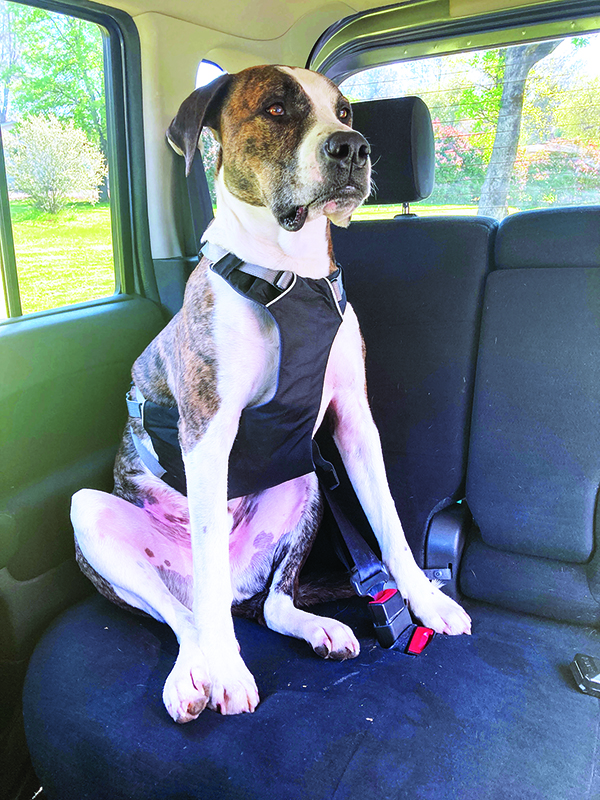
Cars were invented for humans to travel in, comfortably and safely. It’s only recently that we humans started bringing our dogs with us everywhere we go, and even more recent that we have become concerned about our dogs’ safety in cars, too.
Unfortunately, it’s a little late in the game to try to marry our dogs’ safety with existing car designs. Automobile seats and seat belts are designed to securely hold human bodies that are sitting upright and facing forward against those seats in the event of a crash. The technology is amazing; it works more often than not to hold drivers and passengers in place during the wildest crashes – but only human passengers. Dogs are still not faring well in car accidents.
Jump To: Dog Car Harness Review | About Harness Designs | Best Dog Car Harnesses + Runners Up
The dogs who survive car accidents in the best shape are those who were contained in well-engineered and strongly built crates that were securely strapped to solid anchors or bolted to the car itself. These very expensive crates (starting at about $500 and going up, up, up) are, without a doubt, the safest way to transport a dog.
But many of us have cars that can’t accommodate a properly secured crate – and you are not doing a dog a favor by putting him in a regular crate – the kind you use around your home for short-term confinement – with the crate unsecured in your car. There are crash-test videos of regular crates with dog crash-test dummies inside and they are not pretty to watch. Household crates fly apart like matchsticks.
If they are unrestrained in a car when it crashes, dogs tend to fly through the air in the car like projectiles and often “punch through” car windows. In an effort to increase our dogs’ safety while riding in a car that can’t accommodate a strapped-down mega crate, we are stuck with the next best solution: trying to strap dogs onto car seats using a combination of harnesses and car seat belts.
The Challenges of Developing a Dog Car Harness
The companies that attempt to design, build, and sell a product that can accomplish this feat should be applauded; there is a huge and urgent need for a product that works to secure the dog – and many challenges to overcome:
✓ First, the company has to find a design and materials that are strong enough for the job. Again I will refer you to crash-test videos that show a great number of inferior products – products that probably seemed plenty strong before being subjected to a simulated 30 mile-per-hour car crash, but that ripped apart as if they were made with Velcro, sending the crash-test dummy dogs flying. Sincere thanks go to the Center for Pet Safety, a private organization that started making and releasing these videos to raise public consciousness about the lack of adequate safety products for dogs.
After seeing a few of these videos, we quickly realized that we couldn’t possibly include any product in our considerations that wasn’t subjected to a crash-test with video footage that is available for public viewing. This single criterion eliminated the vast majority of the products on the market today.
✓ Another challenge: Once crash tests have helped them find a design and materials that won’t break or tear, they have to deal with the next weak link: the dog’s body.
When you strap a relatively squishy and heavy body (a dog) to a far heavier object (a car) with unbreakable straps, and then subject the whole melange to strong forces, the effect that the straps will have on the dog’s body must be considered. Narrow straps will cut into the dog, so the straps need to be wide. A wide web – a chest plate – is needed to contain the bulk of the dog’s body, because a strap just can’t contain it.
✓ The final challenge: Because dogs’ bodies come in so many shapes, the whole thing has to be highly adjustable and not impossible to put on the dog. It’s a Herculean task!
Candidates for the Best Dog Car Harness
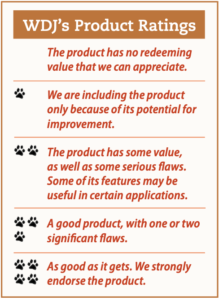
We sorted through ads and other reviews, looking for products to review. After applying the critical criterion for selecting a canine car harness – that the manufacturer has subjected the product to crash tests that are viewable online – there are just five candidates:
• EzyDog’s Drive Dog Care Harness
• Kurgo’s Impact Seatbelt Automotive Harness
• Ruffwear’s Load Up Dog Care Harness
• Sleepypod’s Clickit Sport
• Sleepypod’s Clickit Terrain
Of the two Sleepypod products, we selected the Clickit Terrain to test. The Terrain is beefier than the Sport, and since we were looking for the safest product available, we bought only the Terrain to try.
We got fooled by another candidate, the Reddy Road Trip Crash-Tested Dog Harness, which is made for Petco and sold there (though we saw it offered for sale on Amazon and elsewhere, too). We ordered the Reddy Road Trip and were well into testing it before we realized that we couldn’t find its crash-test videos anywhere, and so we eliminated it from further consideration.
Lesson learned: Just because the words “crash tested” are in the product name or in the product descriptions, unless those videos are available for viewing, the words are meaningless. Without proof to the contrary, we suspect that these products did not survive their crash tests intact.
WDJ’S TOP PICKS FOR DOG CAR HARNESSES
WDJ Rating | Product Name | Price | Available sizes | Comments |
|---|---|---|---|---|
| 3 out of 4 | Ruffwear Load Up Dog Car Harness Bend, OR ruffwear.com (888) 783-3932 | $80 | 5 sizes, for dogs with a girth (chest) 13 to 42 inches | This is the most comfortable and least restrictive of the harnesses we tested, giving our tall test dogs the least amount of anxiety (but perhaps also offering the least amount of safety). Ruffwear’s site says the Load Up harness has been updated and that all sizes of the exact model we reviewed will start becoming unavailable. In August, the new version will be available in all sizes. The only difference, a Ruffwear spokesman explained, is the buckles that are used to connect the back of the chest plate section to the back plate. The spokesman said that consumers found the current “nesting” buckles to be difficult to manipulate. She went on to say that the new buckles have been crash-tested and that video of those tests will be released when the new product is on the market. |
| 3 out of 4 | Sleepypod Clickit Terrain Pasadena, CA sleepypod.com (626) 421-6818 | $95 | 4 sizes, for dogs 18 to 110 lbs or girth of 16 to 40 inches | We believe this is the safest product we reviewed, due to its “Infinity Loop” vest-like design, which offers no potential points of failure in case of a collision. However, once buckled into the car, our test dogs also found it to be the most restrictive, due to the way the seatbelt presses on their backs. This is definitely worse for tall dogs; shorter dogs may not find this as oppressive. A D-ring on the back enables owners to attach a leash; smaller D-rings on the four corners are for the option of attaching a complementary “Terrain Pack” for the dog to carry when walking on trails. Sleepypod offers a “crash replacement program” and will replace or provide a replacement discount on any pet carrier or safety harness damaged in an auto accident, regardless of brand – WOW. See website for details. |
| 2 out of 4 | Kurgo Impact Seatbelt Automotive Harness Salisbury, MA kurgo.com (877) 847-3868 | $76 | 4 sizes, for dogs 10 to 108 lbs | We were impressed with the continuous, single-strap design of this product, which offers few points of potential failure in a collision. We wish the straps were a bit wider; it hurt to watch the crash-test videos, which showed the straps cutting into the test-dog dummy quite a bit (though the product held the dummy on the seat, as designed). Depending on where your dog fits in the range of sizes accommodated by each size of the product, there may be more or less excess strap forming the loop that the seat belt is threaded through. If the loop is too big, the dog will be less secure once belted in; try the next smaller size. Harness has double D-rings for leash attachment. |
| 2 out of 4 | EZYDOG Drive Dog Car Harness Sand Point, ID ezydog.com (877) 339-9364 | $115 | 3 sizes, for dogs 15 to 65 lbs or girth of 11 to 42 inches | Made with wide vehicle-tested seat belt webbing and a molded neoprene-padded chest and back plates. Straps have numbers printed on them to make it easy to adjust the straps on either side to the same length so that the product is centered properly on the dog’s body – genius! To fasten to the car, the car’s seat belt is threaded through two loops on the back of the harness, the most vulnerable point in this design. Harness has double D-rings for leash attachment. |
Common Reviews on Dog Car Harnesses: Discomfort and Inconvenience
If you read user reviews of these products, you’ll see that many people don’t seem to fully understand the challenges that we’ve described above, and this lack of understanding leads them to complain about how heavy, bulky, stiff, and hard to adjust these products are. They also complain that it’s a hassle to have to put these harnesses on the dog for a car ride and then have to take it off and use a different harness or collar for walking the dog at one’s destination. Everyone wants harnesses to provide car safety and walking convenience.
Only one of the four manufacturers of products that we reviewed said no – it can’t be done. The Ruffwear Load Up harness is alone in refusing to add a leash attachment to their harness – and we actually support this choice. If the product is as strong and bulky as it needs to be for safety, it’s not likely to be all that comfortable for the dog to wear while walking. Putting a leash attachment on the product will just encourage people to use it for walking, too.
But the other manufacturers went the other way, giving their products a leash attachment point for convenience. We’ll just say that we would use these leash attachments for the convenience of, say, walking the dog from the house to the car – not for a long walk with the dog. Remember, these harnesses are built with strength as a primary goal; efforts to make them lighter and more comfortable may well make them weaker.
Ideal Designs for Dog Car Harnesses
One thing that all those failed crash tests taught product designers: Nylon-type straps don’t break; it’s the connection points that fail. How they are fastened to each other or to other materials makes or, ahem, breaks them.
Once this was clear, a design concept emerged as critical to the strongest products: Ideally, the design would use the fewest number of straps and connection points possible.
Ruffwear’s Load Up harness is the least successful at this concept; they apparently made different decisions. Their harness is made with several straps that are sewn to each other; inside and at the top of the chest plate, there is a steel ring that three different straps are sewn to. To secure the dog to the car, the car’s seat belt is threaded through a loop at the very rear of the back plate. This strap is sewn to a steel ring inside the back plate – and the security of the entire harness depends on this and the other sewn connections. It’s a vulnerability.
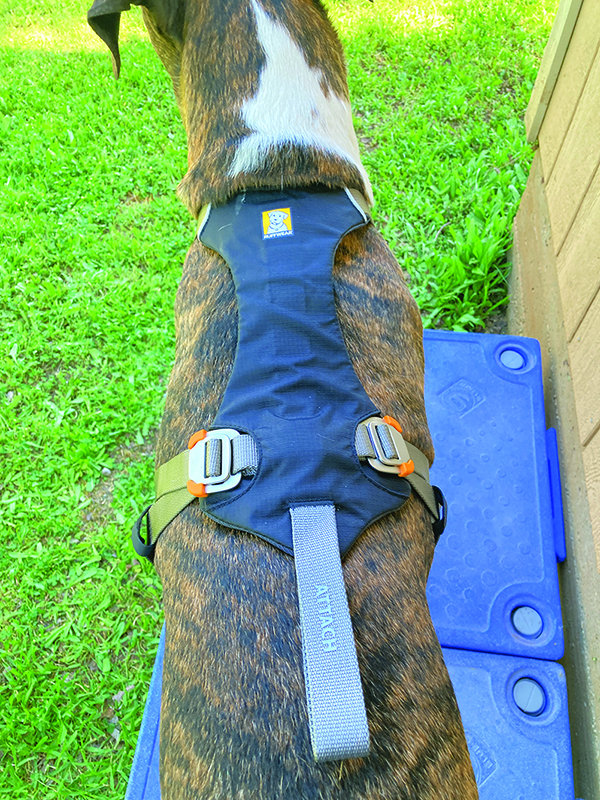
In contrast, Sleepypod’s products are the most successful at meeting the design ideal of reducing connection points. Ballistic nylon cloth, rather than straps, provide the strength of this vest-like garment. Sleepypod calls this an “Infinity Loop” – its “energy-absorbing padded vest” will distribute the force of a crash across the entire harness.
The straps on both of the Sleepypod products are not involved with how the product connects to the car’s seat belt; they are there just to keep the “vest” in place and to provide that connection point for a leash that everyone seems to want. To secure the dog into the car, the car’s seat belt is directed under one side of the vest, over the dog’s back, under the other side of the vest, and then clicked into the seat belt buckle. In an accident, the seat belt will be pulling against both of the long sides of the “Infinity Loop,” helping to distribute the force of the crash.
It would be our prediction that of all the harnesses we reviewed, properly sized and worn, the Sleepypod Terrain is the most likely car safety harness to hold your dog on the car seat in a car accident without suffering a catastrophic failure.
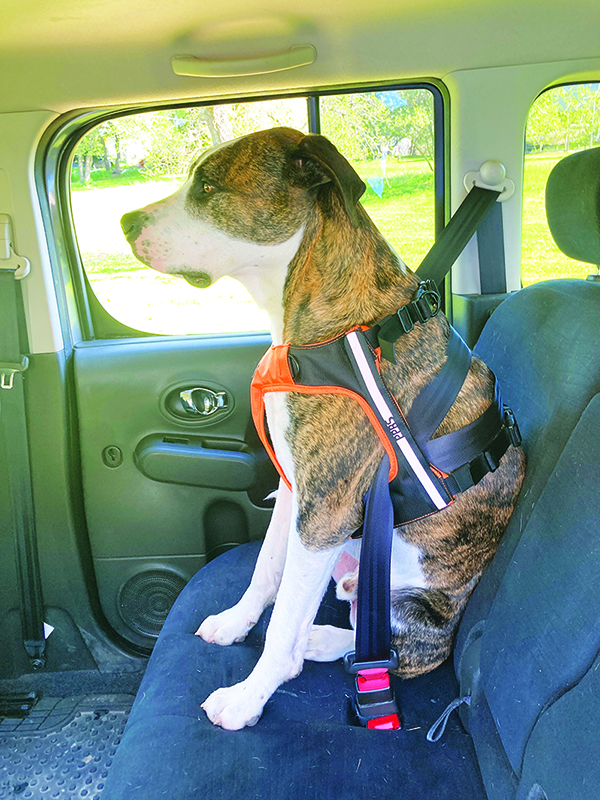
A theoretically similar approach was taken by Kurgo’s Impact Seatbelt Automotive Harness. This product is made with what appears to be a single strap – actually, a “high tensile tubular webbing” – that winds in its own sort of continuous loop around the harness. The strap passes through four steel “nesting buckles” that slide along the strap easily for adjustment; the buckles “mate” with their other halves, which are sewn to a sort of back-plate. The ends of the strap are sewn, out of view, in the center of the padded chest-plate. This is hard to describe, but the ingenious design eliminates as many problematic connections as possible.
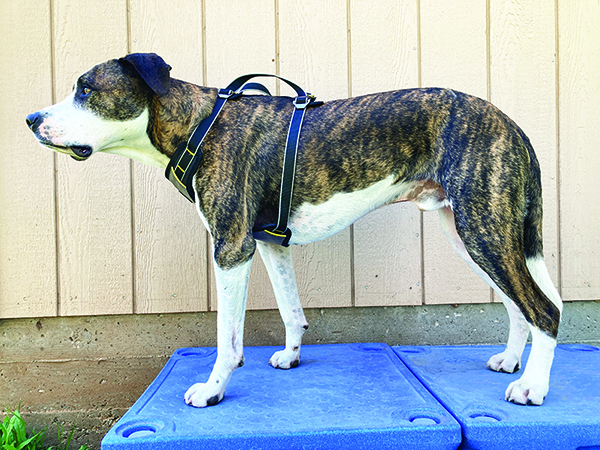
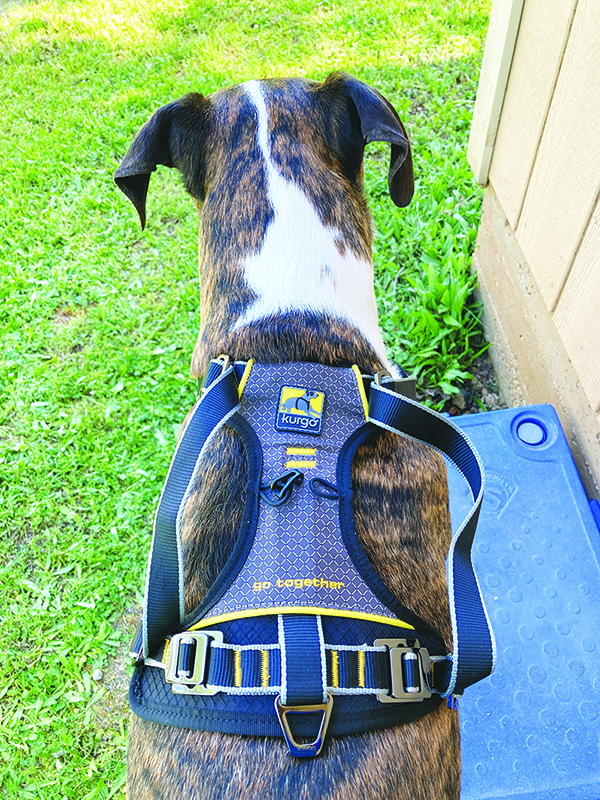
The main body of the EzyDog Drive Harness would appear to be comprised of just two straps made of seat-belt webbing. These straps are much wider than the ones used on Kurgo’s or Ruffwear’s harnesses, making it less likely to press into the dog’s body under severe forces – nice!
These straps are sewn along their length to a molded chest plate, which appears to be a neoprene material in the inside, bonded to a ballistic nylon material on the outside. These straps get securely threaded through some beefy aluminum alloy buckles that are sewn onto two back plates; it’s as if EzyDog took the concept of a back plate and split it down the middle, creating a sort of step-in harness.
Once you have it adjusted to fit your dog (not the easiest process), you can have your dog step in, one front leg on either side of the chest plate, and then fasten the two sides of the back plate together with plastic quick-release buckles.
Each of the back plates has a sewn-on strap that makes a loop. To secure your dog in the car, you direct the seat belt through these two loops and then click the latch plate into the buckle. That makes the place where those loops attach to the back plates both a critical and vulnerable spot in this design.
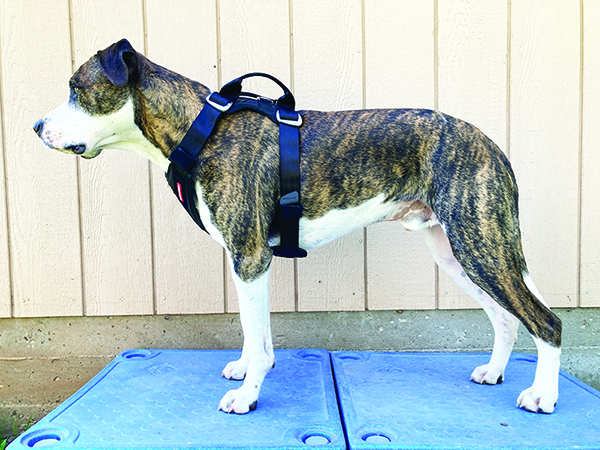
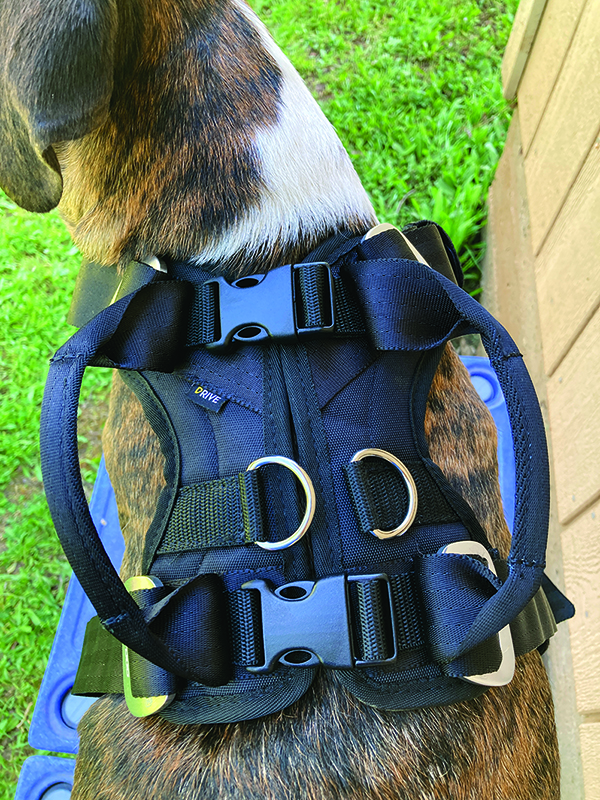
Our Top Picks for Best Dog Car Harnesses
We’ve rated the Ruffwear and Sleepypod products as our top picks, for completely opposite reasons.
The Ruffwear Load Up harness offers the largest chest plate of all the products we reviewed, increasing its potential for distributing the force of a collision across more of the dog’s body. And it’s absolutely the most comfortable of the four products we tested. Due to the location of the seat belt attachment loop, way at the back of the harness, it’s also less restrictive of the dog’s movement and position changes, making it less confining – potentially less scary – for a dog who is used to being able to sit, stand, or lay down on the seat. For that reason, it’s also not quite as safe. The more the dog can move, the greater distance he can be thrown in an accident. When you add the fact that it has more potential points of failure (connection points), it must be considered the most vulnerable of our choices.
Conversely, what appears to be the safest possible harness we reviewed also seemed to be the least comfortable for our test dogs: Sleepypod’s Terrain harness. That is, it’s perfectly comfortable for a dog to wear around, but the way it attaches the dog to the car is highly restrictive. When the car’s seat belt is threaded through the sides of the harness and clicked into place, the seat belt itself acts like a back plate on the dog’s back. Our test dogs are tall and couldn’t or wouldn’t even try to stand with the seat belt fastened in this harness. Again, that’s almost certainly safer for them, but they also found it rather aversive. Shorter, more medium-sized or small dogs would probably not experience this difficulty.
Runners Up
We managed to have divergent reasons for liking and criticizing our two runners-up, too.
We found the Kurgo Impact harness to be more comfortable and less restrictive to our buckled-in test dogs. Also, with its nesting buckles that slide along the strap, it’s a bit of a hassle to adjust and fit properly each time you put it on and take it off the dog, though we got better at quickly making these adjustments with practice. However, we were impressed by the continuous, single-strap design, which offers few connection points that may fail.
In contrast, once it was adjusted and fit properly, the EzyDog Drive harness is a snap to put on the dog, and its wide straps and generous chest plate would certainly be kinder to a dog’s body in a collision than the narrower straps of the Kurgo. This product holds the dog more tightly to the seat, so he’d have less room to be thrown before the straps would catch him in a collision. But we would be concerned about the sewn-on straps that secure the harness to the car; though they appear to be well-sewn in several rows of stitching, this is a point of potential vulnerability.
That said, keep in mind that all four of these products are stronger than every other product on the market, as proven by crash-test video you can see with your own eyes.
Consider your own dog’s size and behavior in your car when selecting a product. If he’s an anxious sort that would panic if held too tightly by his harness and seat belt, as might happen when you have to brake sharply, one of the less restrictive products (Ruffwear or Kurgo) might be the best choice for you.
If your dog is secure and relatively stationary in the car, and absolute safety is your top priority, we’d recommend the Sleepypod harness, with the EzyDog a distant second.
Related Article
Please note that only the Sleepypod products (Terrain, which we tested, and Sport) are approved as “crash test certified” by the Center for Pet Safety (follow the link for more information about the Center for Pet Safety and its tests).
Clickit Terrain Crash Test
Clickit Terrain Instructions
Clickit Sport Crash Test
Clickit Sport Instructions
Information about the Ruffwear product crash tests (from the Ruffwear website):
“Overall Test Summary: The canine restraint was dynamically tested under the conditions outlined in Federal Motor Vehicle Safety Standard 213 Child Restraint Systems (FMVSS 213). The canine restraint was installed on the canine crash test mannequin per the manufacturer’s (Ruffwear) instructions and then secured to the test bench restraint system. FMVSS 213 employs a standard bench seat that represents the rear seating environment of an automobile. The seat bench and add on restraint was then subjected to the 30 mph generic frontal crash pulse detailed in FMVSS 213…
“While Ruffwear’s Load Up Harness has been dynamically (crash) tested under the test conditions of FMVSS 213, the Load Up Harness has not been tested against The Center for Pet Safety’s Safety Harness Crash Test Protocol, which was published on July 15, 2014. The certification test did not exist when we tested prototypes of our Load Up Harness in April 2014 as part of Ruffwear’s product development process. Ruffwear’s Load Up Harness is not ‘CPS Certified.’
“Based on the results of our dynamic tests, the size Medium and Large/X-Large Load Up Harnesses would not meet CPS’s current certification based on the excursion measurement limits defined in the testing protocol. In order for the Medium and Large/X-Large Load Up Harness to test within CPS’s excursion limits, the seatbelt attachment point would likely need to be affixed higher on the dog’s back. We believe that Ruffwear’s seat belt attachment location produces the optimal approach when considering the safety and comfort of the dog.”
Click here to watch the Ruffwear crash test.
Ruffwear Instructions
Information about the EzyDog product crash tests (from the EzyDog website):
“While safety testing and standards continue to emerge in the pet industry, our developers wanted to offer a product that was tested to the most widely recognized government safety standards. With product development primarily in Australia, we turned to the experts at the Automotive Safety Engineering in Australia. This particular testing facility is recognized by the USA (FMVSS 213) Europe (ECE Regulation 21) Australia (ADR42/04) for certification of Child Safety Seats.
“At EzyDog we make every effort to manufacture the best products to protect your pet, however there are no official standards or test requirements for Car Canine Safety products.
“We have chosen to base our product designs such that they conform to a combination of global child safety and vehicle interior standards. We then test our product and obtain conformance using these standards as a guide.”
Click here to watch the Ezydog crash test.
Ezydog Instructions
Information about the Kurgo product crash tests (from the Kurgo website):
“Our Impact harness has been tested up to 108 lbs. at an established University testing facility using the Federal Motor Vehicle Safety Standard for child restraint systems. See below for a link to the crash test report and videos for specific harness sizes and results.
“Our Impact Harness initially passed for dogs weighing up to 130lbs at the University of Michigan testing facility in 2016. Since then, we’ve refined our dog dummy for accuracy, and improved our testing standards. The Impact Harness passed the crash test at Calspan in 2020 for dogs weighing up to 108 pounds using current PPSC testing guidelines. The new crash-test dog dummy has been vetted and will be the standard going forward for PPSC tests. In our effort to act as a leader in the dog safety space, we will continually update our crash-testing methods as industry standards change.”
Kurgo Crash Test Videos
Kurgo Instructions



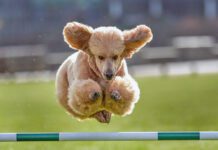


How about very small dogs – 10 pounds and under. We have a car seat but the restraint is wimpy. I prefer to have my dog in the front seat so use a conventional Gooby harness with the seat belt threaded through the top.
Any suggestions?
Look for our review in the June issue of a product just for very small dogs.
My problem (and I’m sure many others have it too): giant breeds who ride in the back of a minivan. With seats folded down there’s nowhere to buckle a harness and their crates, even if they were sturdy enough, are too big to fit in a minivan. Also, all the dogs I’ve had/have (Irish wolfhounds and greyhounds) always travel lying down.
Someone needs to make a cover for the seatbelt buckle that the strap attaches to. My dog keeps stepping on the red release button which releases the strap and thus releases the hold
Kurgo makes a product exactly for that, it’s called the Buckle Barrier! I haven’t used it personally (and the reviews are mixed), but it could be just what you need.
Sleepy Pod also makes a “Buckle Barrier” that comes with their harness plus packs (not available separately). I have never personally used it, but the ease of use of just pinching it open seems ingenious. If you are thinking of purchasing a new harness it may be a nice added touch if you are having this problem.
Wonder if Sleepypod is going tits-up? Checked their site and Amazon and all I see is “unavailable’ for pretty much everything. Was looking into the Click-it Terrain but I guess not now…😡
I’ve asked Sleepypod to comment. I am aware that other companies are reporting delays in receiving products that were manufactured overseas, due to shipping issues related to that giant ship stuck in the Suez Canal.
Here are some comments from Sleepypod regarding their product shortage:
Thank you for including Sleepypod in your review of car harnesses. Following is information regarding availability + a new change to the product:
“Manufacture components availability and subsequent product delivery have resulted in limited availability of the Clickit Terrain car harness. Sizes and colors currently out of stock are available for pre-order on the Sleepypod website with shipping in the second week of May, in a new Clickit Terrain Plus pack that includes the Clickit Terrain harness + S-Clip and Buckle Shield accessories. Sleepypod shifted to selling the harness without accessories first with Clickit Sport in January and now with Clickit Terrain starting with this new shipment arriving in May. The shift to Plus packs of Sleepypod harnesses plus accessories was a result of customer request.
“With regard to the review, as always we deeply respect your thoughts and opinions as they come well researched and without bias. I do want to offer a suggestion for users:
“As with any product that restricts movement, such as a crate or carrier, use of a car harnesses is a shift in behavior and so requires acclimation before use. That’s why Sleepypod always recommends this step for making the shift to car harness use smoother, regardless of the amount of restriction. Car harnesses, like human seatbelts should not allow the passenger to walk about.”
We agree. We should have an “online only” article about acclimating your dog to a car-safety harness posted shortly.
I am thrilled to see new/improved car safety products for dogs; however, I am concerned about any harness that relies on the seat belt. I have owned two Bernese Mountain Dogs, and both of them would step on the seat belt release button within five minutes of our car ride. Do any safety harnesses work with seat belt extenders that are safely secured with the car seat latch for infant car seats?
None of the products that we reviewed work with anything that clips onto the harness, because that strap will both extend the range of the dog — making it less secure — AND become the new weak link in the system. We’ve seen MANY products introduced to the market that feature such a strap, but they don’t last long. Either the snap or the way it’s sewed onto the strap or the strap itself breaks and before long, the product is no longer on the market.
Kurgo sells a cover for the seat belt buckle that prevents accidental paw step releases.
Excellent review.
I’ve bought three of the harnesses mentioned.
Diana pawPrints started with the Petco brand. I did see a video of it’s crash test although I cannot remember where. It only comes in two sizes and has the nesting loops. It’s economical but shows in the narrow straps and smallish unpadded chest plate. But it was fine for her to learn to wear a harness in the car. Diana slowly outgrew them both which is another consideration. One of these does not accommodate dogs over 65 lbs. Diana was 65 lbs at about 9 months. She’s a bit over 100 lbs now which brings up another problem. The bigger the dog, the more difficult keeping them safe in the car, no matter what harness you use. I would question a Fort Knox crate would keep her safe. And all of these crash tests are for 30 mph and under. In the end I believe I bought both the Kurgo and the Clickit. I don’t remember which Clickit I bought but it was listed specifically for the car. I ended up giving the Clickit to my sister for her dog as between the two the Kurgo was both easier to put on and off and I felt more comfortable and safer for Diana. I will have to revisit the harnesses as I believe they may have redesigned the Kurgo since I bought it as the back plate is not as wide as pictured. What I do like are the nesting buckles and infinity loops. I believe both are an advantage to strength. Personally, I don’t think a dog should be able to move around in a car any more than a human should. When we strap children in to car seats or when they are old enough, use seat belts, so we allow them to stand up and lay down in the car? Nope. They need to sit there. Diana can just manage to lay down a bit once she is strapped in but at 100 lbs, she really doesn’t have them much room to do so. And that’s fine. If we are on a longer road trip, I pull over every hour and give her some time to stretch her legs and “rest” if need be. As in rest stop. I will say car harnesses have come a long way since my first dog. He had nothing but a nylon breastplate with some padding and straps with quick release buckles. That was it because there wasn’t anything else. That was just a harness. I guess for walking him. I’m not sure there were car harnesses for dogs 35 years ago. At least not for big ones. Nothing is going to keep my 100lb Diana safe in a crash over 30 mph unless it is a full body harness that securely attaches to two seat belt along the back seat and holds her down in a laying position. Then she might survive relatively unhurt. But I do worry about a dog version of “whiplash.” At one point does anchoring their body lead to injuries to neck and head through sheer force? Also, crash tests are mostly done for head on. We all know that cars can not only be hit head on or rear ended but also t-boned from the side, involving a whole other set of forces. People have limited protection through shoulder straps and air bags. I don’t see harnesses providing much side to side protection.
Interesting that these manufacturers haven’t designed some type of harness or seat-like enclosure to put on the floor of vehicles. I had a dog that survived a crash with just scratches altho’ the accident resulted in the death of the passenger and the hospitalization of the driver. Because the dog was lying on the floor, she didn’t get thrown around the car; just remained in the space under the dash on the passenger side. My car has back seats that lift up to accommodate tall items. A well-padded crate that could be securely attached to the seat hardware on floor level would provide as much protection as a harness on top of the seat I would think. I have the Pup Saver dog seats for my two small dogs. They are designed by a former baby car seat engineer and have been crash tested at 35 mph. They enclose the dog’s body against the seat back during the crash. i believe you may have reviewed them some time in the past.
We have been testing the PupSaver — a product made to protect tiny and small dogs — and that review will appear in the June issue.
Otto and I agree with you about the floor placement; it’s Otto’s favorite place to ride in any car. As soon as the car speed is more than about 20 MPH, he heads to the floor and sleeps (he is not a guy who looks out the window). I think he would be well-protected in most crashes except a rollover.
There really is no perfect solution.
It has been my experience with harnesses and tethers (they are my second choice for restraint; the first being a crate) that the larger breeds step on the seat belt latch and release it. I have found that the Mighty Paw tether (which connects to the latch hook like a child’s car seat) combined with a serviceable harness (I have the Kurgo) is best. I also use bath mats on my leather seats under a car cover for added stability and a barrier for things like wet coats.
Why was the All Safe Dog Harness not included? Are the crash tests too old? I reviewed the tests many years ago and tried the Click It of the time, which used tethers as well as seat belt, and my little Lab managed to Houdini out of it. The All Safe is one I can keep on her and have been using for years and I paid attention to the further testing that said the original long attachment wasn’t good but the company came out with a shorter attachment. Since my dog likes to lie down I will try to find the Ruffwear and see if it will fit her OK and if it stays on her. Thanks for your research and covering this topic. My car won’t accommodate one of the sturdy, secured crates and harnesses are a must for me.
I don’t understand why you didn’t review a harness that uses the latch connecter system in a car. I currently use the Mighty Dog strap that connects to the latch system in my car, and clips into their car harness. I don’t love the harness, for the precise reason you state–some of the straps are thin. But I was hoping at least one of these harnesses would use that system. My 40 lb Belgian Tervuren has a knack for stepping on the seat belt release and freeing herself. She has never freed herself with the latch strap. Please take a look at this system!
Thanks so much for the very thorough review! I don’t see links to crash test videos, but it’s easy enough to visit the manufacturers’ websites.
Do you ever come across anything that doesn’t require snapping the seatbelt shut? I have a Honda Element with the rear seats removed. The female end of the seatbelts is attached to the seat. So when that is removed all you have in the back are the straps and the male end of the buckle. I’ve been searching high and low for a dog safety belt that would somehow work with just the seatbelt and male connector.
The unavailability of many dog products may be due to the massive adoption of dogs after the COVID lockdowns. Dog-related products are scarce.
What about about the Julius K-9 harness? I had it on my 90 lb. boy, who crossed the Rainbow bridge last year, and it was great. He was not a tall dog, but it worked very well in my backseat and he never was upset having to put it on after 8 years of having nothing to wear. Knew when he saw that, he was going somewhere in the car!! He was diagnosed with cancer and we had to go to Ohio State University Veterinary Clinic which is about an hour and a half from us and I didn’t want to worry about him on that long a trip, so got the Julius on recommendation from my son who had 2 huskies, who had them. I would recommend that one also. The harness slips over their head, and fastens to a strap which fastens to the seat belt clip and has a very well padded chest and closure. Comes in colors too!!
Our new rescue was able to chew through the strap the seatbelt goes through. The harness was an older Roadie by ruffrider. So now we are looking for a harness that keeps the seat belt connection behind and out of reach. Is there such a thing?
I tried to order the Ruffwear harness today, and every size but the smallest is out of stock everywhere online. I emailed the company, and they replied that they’re out of stock “for the season” and in the process of redesigning the product. I was told to “look for the new model in August/September 2021!” Sigh. Thinking of the EZDog as a backup. My dog would never tolerate the confinement of the Sleepypod, that much I know. The fact that it’s one and done on the sizing makes me inclined to favor the EZDog over the Kurgo (though I’ve used other Kurgo products before and liked them—that buckle cover to prevent accidental unlatching of the seatbelt really works!). Thanks for the helpful review!
Why is the video of the EZY Dog Drive harness not working? There’s a slash through all the play icon arrows & they will not play.
Also, was EZY Dog’s previous licking slide attachment defective? I seen they’ve switched to snap lock buckles.
Lastly, the review on Sleepypod did not address reviewers complaining about permanent twisting & distortion of the neoprene when worn by bigger dogs. Has this problem been addressed?
Hello,
Very informative article, I belong to an organization that trains service dogs and we have always been advised to have our dogs on the floor because it is the safest position for them. Some are just too big. My question is has the Center for Pet Safety ever done a test on the dog being in that position or do you know of any data that helps support this ?
I haven’t seen any data that supports this, but it’s my experience, also, that a dog sitting or laying on the floor has less room to get thrown around or gain velocity. However, in a type of crash where the car gets crushed, it may be less safe than being on the seat.
I’d like to reiterate that cars are made for human safety, and the fact that dogs ride in all positions, none similar to the posture of a human, complicates everything about car safety for them.
Ruffwear Load Up Harness made in August 2021 was recalled in January 2022. Would be nice if this article could have an updated note to alert consumers to this.